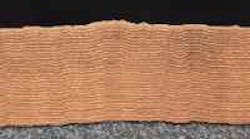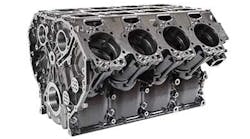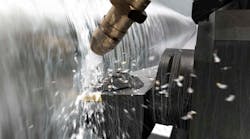According to one cutting tool manufacturer, coating an insert with hundreds of ultrathin layers is better than using just a few thick ones.
Shown at 6,500 magnification, the SpectraMill grade SM245 insert has 62 MLCVD layers. WidiaValenite's new coating process can deposit more than 200 ultrathin layers on a single insert.
Designed for threading and grooving applications, ST145 inserts with MLCVD layers deliver up to 4 the tool life over the previously available product.
A machine tool builder used an SM245 insert coated with MLCVD layers to face and rough profile mill a flamecut steel bedplate at 600 sfpm, 0.007 ipt feed, and 0.125 in. depth of cut. The company improved tool life 25% by changing from a CVD grade with an aluminum oxide (Al2O3) coating to the WidiaValenite SM245.
A year ago, WidiaValenite introduced multilayer chemical vapor deposition (MLCVD) technology, which produces extremely thin layers of coating material on an insert substrate. In pre-introduction testing, the first MLCVD milling grade, SM245, performed well over a wide variety of workpiece materials and milling operations.
Since then, however, MLCVD inserts have proven themselves in production applications, extending tool life as much as 400% over conventionally coated tools.
SM245, which is coated with titanium nitride (TiN) and titanium carbonitride (TiCN), has been available as a standard grade for ferrous milling applications under uncontrolled field conditions. Material applications thus far have focused mainly on stainless, alloy, and mild steels.
A machine tool builder skilled in optimizing metalcutting operations was among the first SM245 customers. In one typical application, the builder faces and rough profile mills a flamecut steel bedplate for one of its machines. This is a difficult operation because of the rough, flamecut surface and the presence of slag and other residue from the cutting operation.
The customer has been using a CVD grade with an aluminum oxide (Al2O3) coating to handle the abrasive conditions, but with only moderate success. Substituting WidiaValenite SM245 in the same application (600 sfpm, 0.007 ipt feed, and 0.125 in. depth of cut) improved tool life 25%.
Success, in this case, was attributed to the toughness of the insert's TiN and TiCN coatings and the improved crack resistance of the multilayer coatings. In fact, the lower abrasion resistance of the TiN/TiCN coating as compared to the Al2O3 was more than compensated for by the MLCVD-coated insert's substantially greater crack resistance.
The builder also increased tool life over 300% milling steel turrets with SM245. In this operation, the company used a 10-in.-diameter, 8-tooth cutter to face mill steel turret castings at 420 sfpm and 0.009 ipt feed. Replacing a conventional CVD insert coated with TiN, the SM245 provided 3 the tool life.
The MLCVD concept
Multiple coatings, of course, are nothing new. Traditional coated inserts have multiple layers of materials like TiN, TiCN, and Al2O3 to protect a substrate from heat, friction, and wear during a cut. These coatings are relatively thick, and a normal insert will have only two or three layers.
WidiaValenite's MLCVD process represents a radically different approach. Instead of a few thick coatings, MLCVD applies a large number, hundreds in some cases, of extremely thin coatings to a carbide substrate. The coatings consist of conventional materials, including TiN and TiCN.
These layers are so thin that they've measured in billionths of meter, or nanometers. The thickness of each of the 62 layers on the SM245 insert, for instance, measure roughly 50 nanometers.
Why thin is better
What makes multiple ultra-thin coats perform better than a few thick ones? The greatest single advantage of an MLCVD coated insert is that it resists microcracking through the coating structure.
In the cut, an insert is heated by friction and subjected to physical impact and thermal shock, all of which produce microcracks at the contact surface. Those microcracks then propagate through the coating structure and into the substrate, weakening and eventually destroying the insert.
An MLCVD-coated insert is subject to the same forces, but it has two unique mechanism to resist damage. First, the MLCVD coatings are so smooth that all known polishing techniques leave them rougher than they are in an unpolished state. This smooth surface minimizes friction and the heat generated as a chip slides across the face of an insert. As a result, the MLCVD-coated inserts run cooler, stay harder, are more resistant to chemical attack, and have less built-up edge problems.
But even an MLCVD coating cracks eventually, and when it does, the second difference comes into play. In a conventional coating, which is about 14 to 18 microns thick, cracks propagate rapidly through the monolithic coating layer until they reach a boundary — typically the inter-face between two layers.
On a conventional insert, a significant portion of the coating is lost because the layers are relatively thick. But in an MLCVD insert, a surface microcrack is stopped within nanometers by the boundary of the underlying layer, so it never has a chance to propagate.
With the potential for hundreds of boundaries for cracks to cross before they can reach a substrate, the theoretical life of an MLCVD insert is many times that of a conventionally coated insert. Also, the adhesion of MLCVD is superior to CVD, providing better resistance to spalling and pullout when machining gummy materials.
Future developments of MLCVD technology
WidiaValenite believes its multi-layer-coating technology might someday replace conventional coatings. The company is currently coating inserts with materials other than TiN and TiCN, such as Al2O3 for high speed applications.
In addition, it is also developing processes for new coatings, called MTMLCVD (Medium Temperature MLCVD), which incorporate ZrCN and TiN. This work has been quite encouraging because lowering the deposition temperature of a coating makes it tougher without losing wear resistance.
The automotive industry, in particular, could benefit greatly if an MTMLCVD product becomes commercially available. This is because nodular irons, which include compacted graphite, have a higher tensile strength than cast iron. However, they are often gummier and harder to machine. In in-house tests, MTMLCVD has beat out commercially available MTCVD in turning nodular iron.
And although WidiaValenite has not yet tested aluminum, it believes MLCVD technology has great potential there as well.









